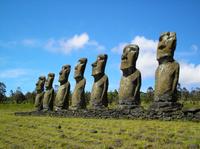Easter Island Moai Archaeology Tour: Ahu Akivi, Ahu Vinapu and Puna Pau
Hanga Roa, Chile
Rating: 









Trip Type: Archaeology Tours
Duration: 3 hours 30 minutes
Delve into the archaeological mysteries of Easter Island's Rapa Nui National Park on this half-day tour. Stand before ancient 'moai' stone sculptures carved by the indigenous Rapa Nui, learn why the moai at Ahu Akivi face the ocean, and dig deeper on the topic of why the masonry at Ahu Vinapu has perplexed experts. You'll also visit the harbor town of Hanga Piko to observe a restored ceremonial moai.
More About This Activity All Archaeology Tours →
Delve into the archaeological mysteries of Easter Island's Rapa Nui National Park on this half-day tour. Stand before ancient 'moai' stone sculptures carved by the indigenous Rapa Nui, learn why the moai at Ahu Akivi face the ocean, and dig deeper on the topic of why the masonry at Ahu Vinapu has perplexed experts. You'll also visit the harbor town of Hanga Piko to observe a restored ceremonial moai.
Rapa Nui National Park, a wildlife sanctuary spread across most of Easter Island and a UNESCO World Heritage site, contains about 900 moai sculptures as well as 300 ahu, or ceremonial platforms, on which the carved figures stand. Sculpted from solidified volcanic ash, these statues are believed to represent the spirits of ancestors and high-ranking members of each tribe.
After hotel pickup from Hanga Roa, travel south with your guide into the park to Ahu Vinapu, one of the larger ceremonial sites. See how the precise cuts of basalt (a volcanic stone) that make up the platform are meticulously fitted together. It's arguably the most advanced masonry found on the island.
Continue north to Puna Pau to see how some moai sport a different look. You'll notice they have pukao, or topknots made out of red scoria on their heads. It's believed the volcanic rock was used to impress rival tribes. Roughly 30 pukao are located in or near the Puna Pau quarry, the source of the red scoria.
Break up the trip with a brief stop at the harbor of Hanga Piko to examine the restored Ahu Riata moai who watches over fishermen.
Then head to Ahu Akivi, where you’ll see a line of seven moai looking out toward the ocean. The moai here each stand 16 feet (5 meters) tall and weigh about 18 tons (16 metric tons). What's mysterious about these sea-facing figures? It's an unusual sight considering the other ahu moai stand with their backs against the water.
One theory behind their unusual position: These moai symbolize the seven explorers from the Polynesian homeland of Hiva sent by the chief to find the island of Rapa Nui (now Easter Island). According to this hypothesis, these statues face the ocean in the direction they came from.
After your engaging exploration of ahu moai, you’ll be taken back to your hotel.
After hotel pickup from Hanga Roa, travel south with your guide into the park to Ahu Vinapu, one of the larger ceremonial sites. See how the precise cuts of basalt (a volcanic stone) that make up the platform are meticulously fitted together. It's arguably the most advanced masonry found on the island.
Continue north to Puna Pau to see how some moai sport a different look. You'll notice they have pukao, or topknots made out of red scoria on their heads. It's believed the volcanic rock was used to impress rival tribes. Roughly 30 pukao are located in or near the Puna Pau quarry, the source of the red scoria.
Break up the trip with a brief stop at the harbor of Hanga Piko to examine the restored Ahu Riata moai who watches over fishermen.
Then head to Ahu Akivi, where you’ll see a line of seven moai looking out toward the ocean. The moai here each stand 16 feet (5 meters) tall and weigh about 18 tons (16 metric tons). What's mysterious about these sea-facing figures? It's an unusual sight considering the other ahu moai stand with their backs against the water.
One theory behind their unusual position: These moai symbolize the seven explorers from the Polynesian homeland of Hiva sent by the chief to find the island of Rapa Nui (now Easter Island). According to this hypothesis, these statues face the ocean in the direction they came from.
After your engaging exploration of ahu moai, you’ll be taken back to your hotel.
« Go Back

